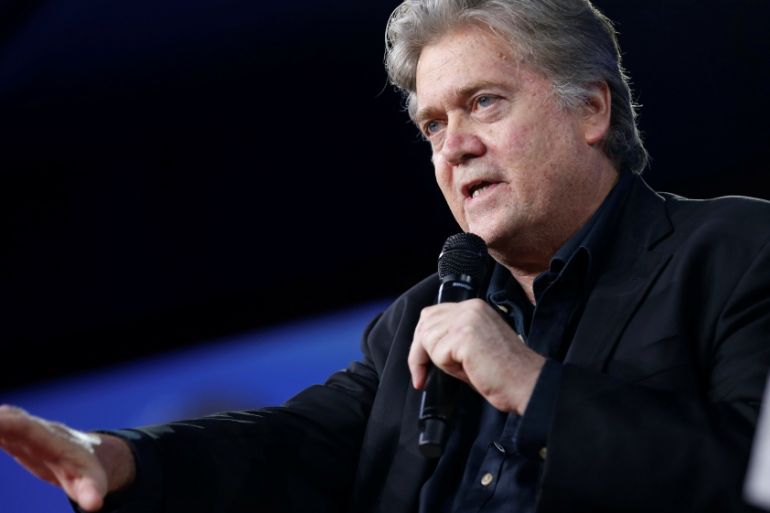Remaking the Republican Party: Populism a la Trump
Donald Trump and his chief adviser Stephen Bannon signalled a total rebranding of conservatives at the CPAC.

Even though US President Donald Trump has been criticised by “true” conservatives for his past liberal positions on social issues and his denunciations of trade pacts, his February 24 speech at the Conservative Political Action Conference (CPAC) was widely applauded.
His comments, and those of his chief adviser, Stephen Bannon, suggest that he aims to take the Republican Party in a more populist and nationalist direction, and believe that traditional conservatives will be forced to fall in line.
Keep reading
list of 4 items‘We love Taiwan’: Domestic workers hope for more from new President Lai
Cohen admits to stealing and other takeaways from day 19 of Trump’s trial
Iran announces five days of mourning after President Raisi’s death
Although Trump did mention some orthodox conservative positions, such as cutting taxes and regulations on business, much of his speech was aimed at showing the conservative rank and file that the popularity he gained during the election campaign means that he, not the traditional conservative movement, is setting the agenda – a concentration on militarism, economic nationalism, and populism.
Trump promised a large boost in defence spending so that their adversaries would not think of challenging the United States.
He coupled this message with a pledge (again) to destroy the Islamic State of Iraq and the Levant (ISIL, also known as ISIS) and implement a restrictive immigration policy aimed at what he said was preventing “radical Islamic terrorists” from entering the US.
How Trump plans to increase defence spending dramatically while cutting taxes and not ballooning the deficit (long a conservative pillar) was not mentioned.
He may believe that more business activity and job growth in the US will, in the end, generate a larger tax pool, but the math right now simply does not add up.
‘America only’
Regardless, these all fit into Trump’s “America first” ideology that he enunciated during the campaign. His speech at CPAC has taken this ideology one step further. One can now call it “America only”.
He emphasised to the CPAC audience that he is president of the US, not a president “representing the globe”, and was going to make sure that his economic policies only benefit American business and American workers.
Such comments were also emphasised by Bannon, a self-described American nationalist who founded the right-wing media outlet, Breitbart.
At the same CPAC conference, Bannon said Trump’s first line of work is “economic nationalism” which he defined as renegotiating trade deals to benefit the US and bring back “high value-added” manufacturing jobs.
OPINION: Donald Trump’s presidential diplomacy deal?
This messaging on jobs for Americans only is also unorthodox for traditional conservatives who have long favoured free trade and have been loathe to put restrictions on American businesses wishing to move overseas.
Reinforcing populism
By contrast, Trump stated that the Republican Party should now be the party of “workers”. This appeal to populism is not only aimed at weakening the Democrats who have long had ties to the trade unions, but also in steering the Republican Party to working class constituents who believe they have lost out to “globalisation”.
Trump also spoke about his meetings with unions, as well as business leaders, suggesting that the former would continue to have a link to the White House despite the fact that his cabinet is dominated by millionaires.
READ MORE: Samuel Ronan – Democrats ignored working class for years
Finally, he saved special wrath for the media, which he denounced for propagating “fake news” and described some of them as “enemies of the American people“.
These comments came on the heels of Bannon’s remarks a day earlier in which he accused the “corporatist, globalist media” of adamantly opposing Trump’s economic nationalist agenda.
Soon after Trump’s denunciation of the media at CPAC, several prominent American news organisations, such as CNN, the New York Times, and the Los Angeles Times were barred from a White House press briefing.
Not surprisingly, such media lambasted the Trump administration for infringement on freedom of the press, considered sacrosanct in American law and culture.
Although this is not the first time Trump has denounced the media, it does represent his first punitive action as president against them.
OPINION: For Europe, questions remain as to US foreign policy
Prominent Republican Senator John McCain – Trump’s nemesis in the US Senate – warned several days earlier that restrictions on the press are “how dictatorships start”.
Although McCain prefaced his remarks by stating that he was not saying Trump was trying to be a dictator, the political class in Washington read his comments as a comparison to a dark era of the 1930s in Europe.
Indeed, when one adds up Trump’s appeal to populism, his stoking fear of “the other” (in the case, Muslims), his infatuation with militarism, his economic nationalism, and his relishing of a fight (Bannon warned CPAC, “if you think they’re going to give your country back without a fight, you’re sadly mistaken”), all of this points to elements of fascism.
The key question for the Republican Party is whether they want to throw their lot in with a president who seems to have contempt for the Constitution, is alienating millions of Americans, and is relying on an ultra-nationalist ideologue for guidance or do they want to stick with principles that McCain and others hold dear.
Gregory Aftandilian is a lecturer in the Pardee School of Global Studies at Boston University and is a former US State Department Middle East analyst.
The views expressed in this article are the author’s own and do not necessarily reflect Al Jazeera’s editorial policy.
